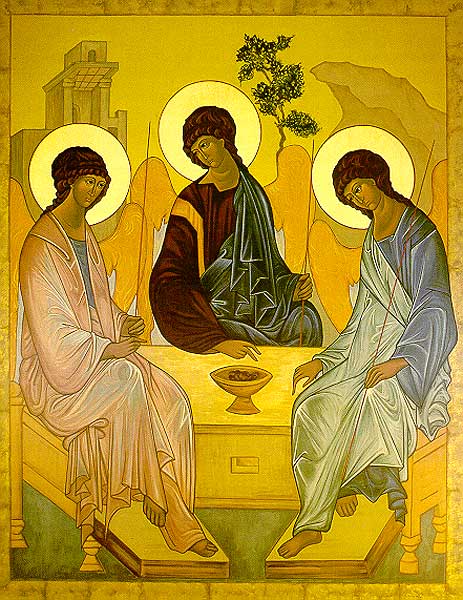

| Item Number | Description | Price Each | Quantity | Total | Action |
|---|---|---|---|---|---|
| ICC003 | 4" X 5" ICON ON WOOD |
$15.99 |
|
$15.99 | |
| ICC103 | 6" X 8" ICON ON WOOD |
$26.99 |
|
$26.99 | |
| ICC203 | 8" X 10" ICON ON WOOD |
$37.99 |
|
$37.99 | |
| ICC303 | 10" X 13" ICON ON WOOD |
$54.99 |
|
$54.99 |
This traditional image of The Old Testament Trinity, originally painted by Andrei Rublev in 1425, shows us the three visitors to Abraham and Sarah described in Genesis 18. Orthodox tradition identifies the three visitors with the three persons of the Trinity.
Wood-mounted icons are on 5/8" ProWood® Medium Density Fiberboard (MDF) with a wood-look foil finish, with tee-slots milled in the back for easy hanging. Icons are finished in classic cherry to replicate the traditional icon red, in keeping with Byzantine tradition. (Ancient icon board edges were frequently coated with red bole, a form of clay). Each mounted icon comes with a descriptive pamphlet explaining the symbolism and history of the image.
Please allow 5-10 business days for orders of 20 or more icons.
Our icon designs are also available as unmounted prints in sanctuary-size enlargements up to 38 inches wide. The latest technology enables enlargement without sacrificing quality. We do not currently have the ability to mount these prints on wood or any other material. You may purchase your own frame from a custom frame shop. Call 800-889-0105 for pricing and ordering.
Christianity has struggled to understand and to interpret the Holy Trinity both in words and in pictures throughout its history. Most attempts to portray God the Father or the Holy Spirit have been rejected by Orthodox councils as being counter to theological understanding. The only representation to stand the test of time is this one, presenting the Trinity symbolically represented by the three mysterious visitors to Abraham and Sarah described in Genesis, Chapter 18.
Earlier icons of the Three Visitors at the Oaks of Mamre were more realistic, showing Abraham and Sarah waiting on them, the tent in the background, a well-furnished table, and even a servant killing a calf. But in the fifteenth century, the holy and very famous monk and iconographer Andrei Rublev created the simplified and beautiful pattern you see in our reproduction. A council of the Russian Church in 1551 declared that Rublev’s composition is inspired by God. Little is known about Andrei Rublev, even though he is Russia’s most famous iconographer. He was a monk of the Monastery of the Trinity at Zagorsk. He created this Trinity icon sometime between 1411 and 1422 in memory of the monastery’s founder, St. Sergius. The original is now in the Tretyakov Gallery in Moscow. Our reproduction is of a twentieth century icon that follows Rublev’s design very closely and is easier to study than the original, which is heavily damaged.
The basic geometric form of this composition is the circle, uniting the three figures in a flowing pattern. Inverse perspective is employed to draw the viewer into the circle as well. Inverse perspective is a deliberate distortion of natural visual perspective in which similar objects that are closer are drawn smaller than ones that are further away.The three visitors are depicted as angels, signifying that they belong to heaven rather than to earth. Their faces are essentially identical, representing the equality of the three Persons of the Holy Trinity. They are also essentially gender neutral in appearance.
There is disagreement among scholars about the identity of the three figures. Some say that such identification should not be made, since none of the three figures is meant to resemble in actuality any specific Person. However, other sources find considerable symbolic justification for linking the figures as viewed from left to right with Father, Son, and Holy Spirit.
The angel on the left (Father) is wearing a cloak of an indefinite hue, pale pink with brown and blue-green highlights, symbolic of the impossibility of portraying God in visible form. The hand gesture could be pointing to the meat in the dish, or to the second figure (the Lamb of God) or simply holding out one finger signifying the first person of the trinity. Above this angel is a building, symbolic of the Church and worship of God.
The angel in the center (Son) is wearing a dark reddish purple chiton or tunic and a dark blue cloak, which are the customary garments for Christ in most icons. The color of the chiton is symbolic both of Christ’s human blood and His royal status. The blue signifies the mystery of His divine nature. Above this angel is a tree, the Oak of Mamre mentioned in the Genesis account but also symbolic of Christ’s crucifixion. Most icons of Christ show a cross inscribed in His halo. This one does not, since the representation is not actual, but only symbolic.
The angel on the right (Holy Spirit) is dressed in a green cloak, traditionally the color of life and renewal, and a blue chiton of divine mystery. Above this third figure is a mountain, symbolic in iconography of the spiritual journey, or spiritual ascent toward salvation. On the table is a dish containing the meat Abraham prepared for his guests. It rests at the focus of the circular arrangement as a symbol of the Holy Eucharist, the continuing renewal of the Covenant between God and man. On the front of the table is a small, rectangular hole. This symbolizes the "narrow door" to salvation (Luke 13:24).